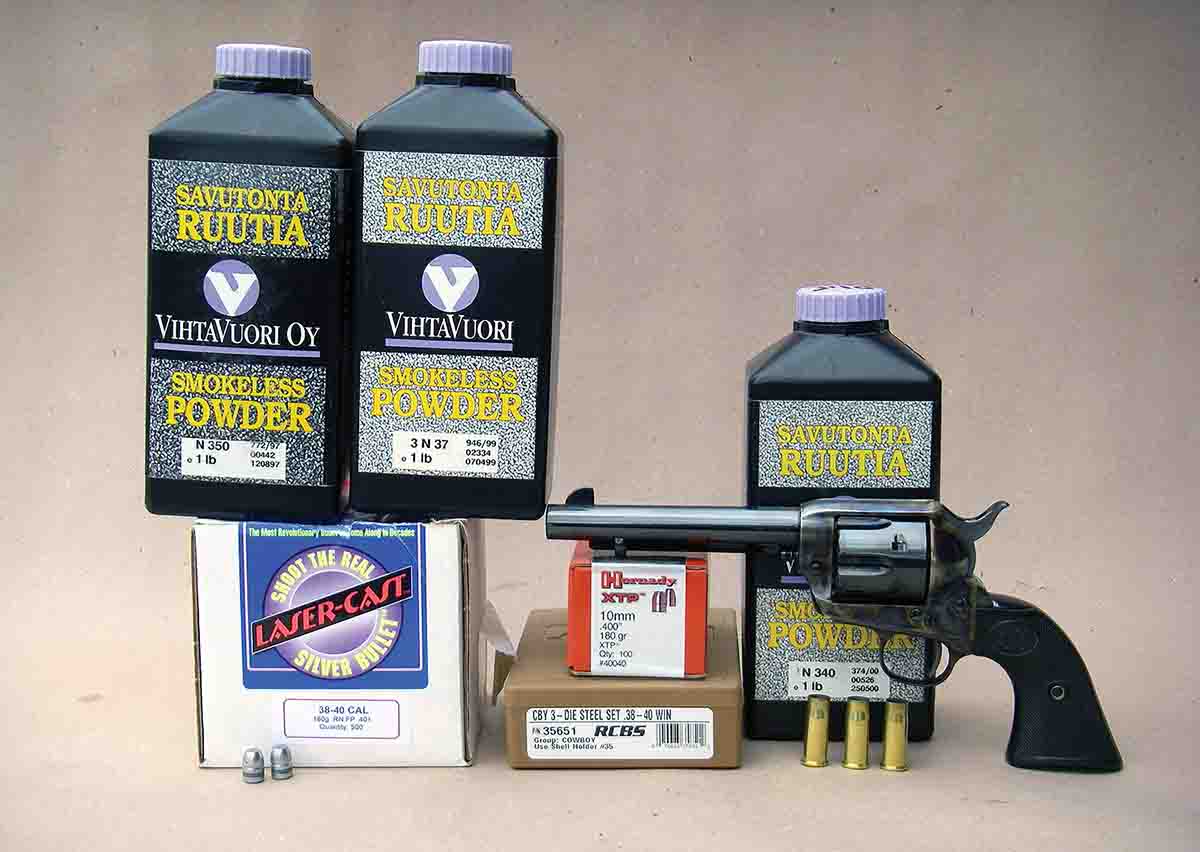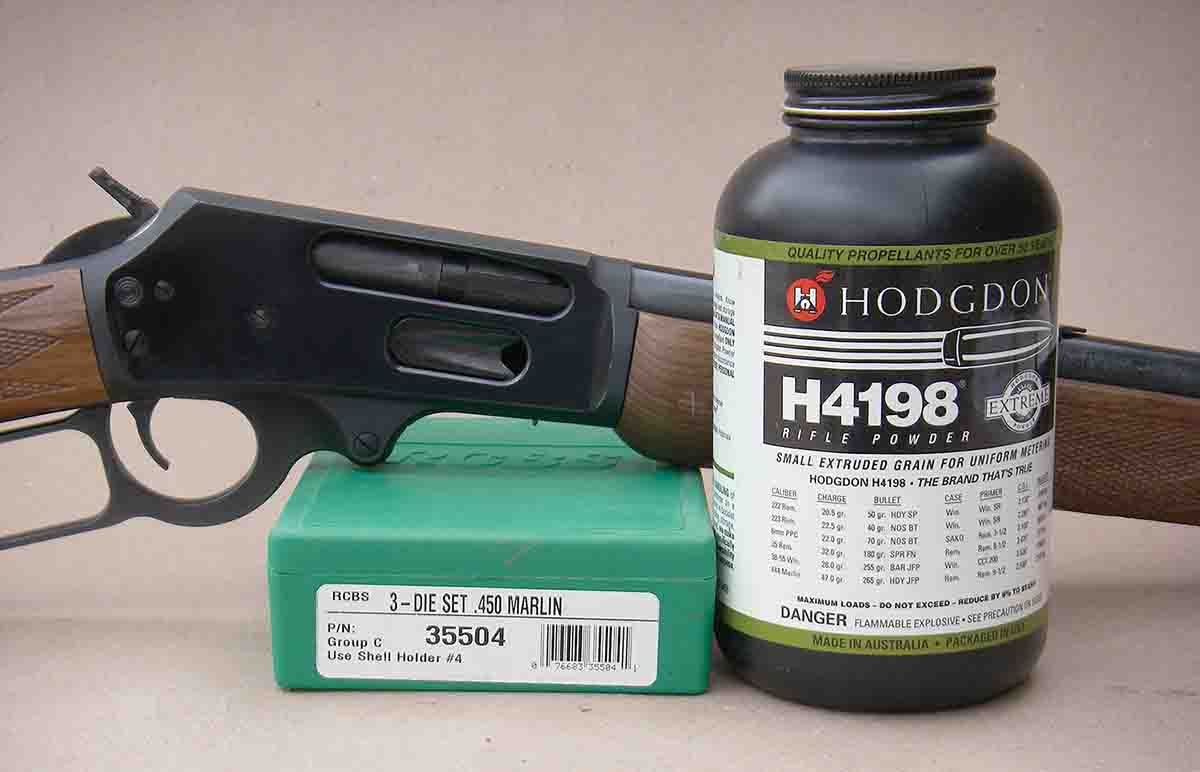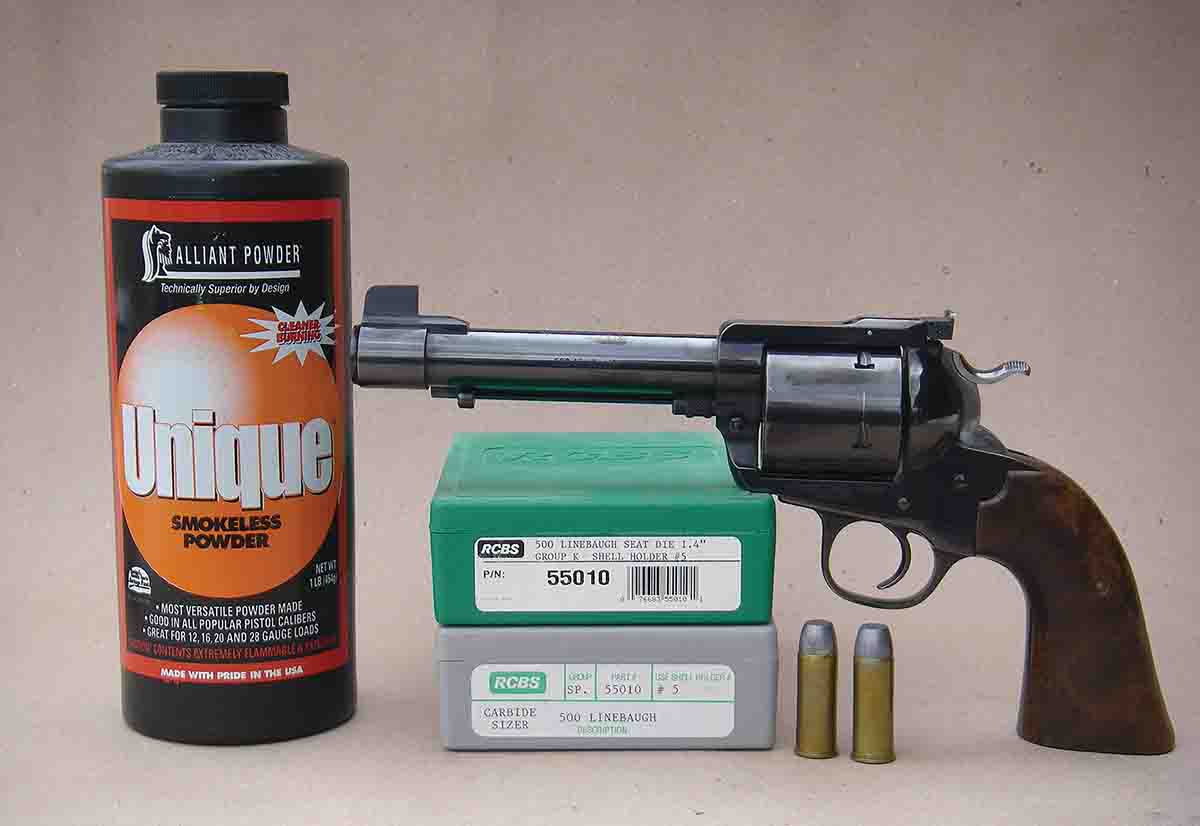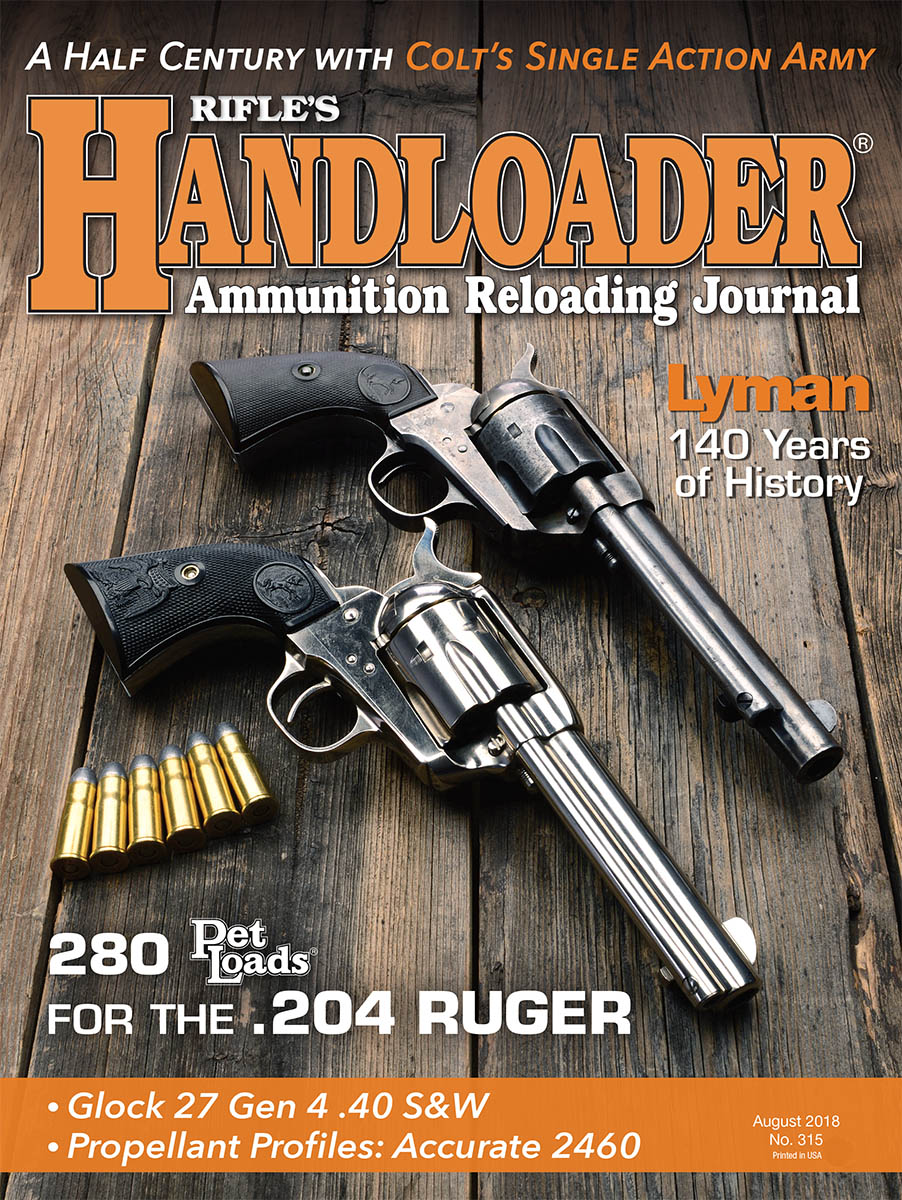Bullets & Brass
Ruger New Model Blackhawk Convertible .38-40 Winchester
column By: Brian Pearce | August, 18

Q: I have been a reader of Handloader magazine since 2013 and really appreciate your articles. I just bought a new “old production” Ruger New Model Blackhawk convertible in .38-40 Winchester and 10mm Auto. In referencing the enclosed paperwork, Ruger states that the gun can be used with “38-40 regular and high speed” ammunition. All of the data that I have found for this caliber are for Cowboy Action Shooting with low pressures and low velocities. Could you please offer some handload data for the 175-grain cast bullet from Lee mould #TL401-175-SWC crimped in the first groove, as well as data with 180-grain jacketed bullets. The powders that I have on hand include Hodgdon Titegroup, Vihtavuori N-110, N-340 and Vectan SP2.
Thanks in advance for your reply. With my best regards. – P.G., Switzerland
A: I am unsure what .38-40 “high speed” ammunition Ruger would have been referring to, as those loads (in factory form from Winchester and Remington) have not been produced for more than 70 years and are highly collectible today. Just for the record, sometime prior to 1905, with the strong Winchester Model 1892 and Marlin Model 1894 rifles (and others) available, Winchester introduced a Special High Velocity .38-40 load labeled “.38 WCF W.H.V.” with a muzzle velocity advertised at 1,776 fps. Variations of this load were soon offered that included 130-, 150- and 160-grain bullets, but in 1938 a 145-grain load was offered that exceeded 2,000 fps. None of these loads were recommended for Winchester Model 1873 rifles or any revolver. It is unclear exactly when all of the high-velocity loads were discontinued, but it appears that most vanished during World War II or soon thereafter. However, into the 1970s there were 180-grain factory loads advertised from a rifle at 1,330 fps, or 975 fps from a revolver, but they were not listed as “high speed.”
Today’s factory loads are generally loaded with a 180-grain JSP bullet at 1,160 fps from a rifle but only yield around 700 to 800 fps in most revolvers.
Your Ruger New Model Blackhawk is built on the “44” cylinder frame and is therefore very strong and certainly capable of handling notably greater pressures and velocities than current factory loads. I have had experience with the Ruger .38-40, with my sample proving extremely accurate with select loads.
Since you don’t state what velocity you are trying to achieve, select loads offered reach 1,000 to 1,200 fps and are intended only for the Winchester Model 1892, Marlin Model 1894, your Ruger New Model Blackhawk Convertible and U.S.-manufactured USFA SAA-pattern revolvers. These loads should not be used in Colt Single Action Army revolvers or other antique designs.
I suggest using Starline cases with CCI 300 Large Pistol primers. Using 175-grain cast bullets from Lee mould TL401-175-SWC, start with 9.5 grains of Vihtavuori N340 for 990 fps, while 10.5 grains will give you 1,118 fps. Increasing that charge to 11.0 grains will produce 1,189 fps.
I realize that in Switzerland your powder selection is limited, but you should have all Vihtavuori powders readily available. So I also developed loads with the above bullet using VV-N350 and VV-3N37 powders. Using VV-N350, start with 11.0 grains for 1,049 fps, then work up to a maximum charge of 12.5 grains for 1,280 fps. Using VV-3N37, start with 10.5 grains for 909 fps and work up to 12.5 grains for 1,170 fps.
Regarding discontinued 180-grain Winchester or Remington jacketed bullets with a crimp cannelure, they have been difficult to obtain for many years – even in the U.S. In developing data for you, I used the Hornady .400-inch, 180-grain XTP-HP bullet but rolled a crimp cannelure into it. Using 9.5 grains of VV-N340 powder, it yielded 848 fps, while 10.0 grains achieved 880 fps, 10.5 grains, 923 fps, and 11.5 grains produced 1,006 fps. Switching to VV-N350, 11.0 grains gave 1,015 fps, 11.5 grains 1,051 fps, 12.0 grains reached 1,073 fps and 12.5 grains hit 1,100 fps.
These velocities were recorded from a USFA Pre-War revolver with a 5.5-inch barrel. I hope this information helps, and I am glad that you are enjoying our magazine.
Browning BLR Lightweight .450 Marlin

Q: I recently obtained a new Browning BLR LT WT (Lightweight) Stainless chambered in .450 Marlin with a 20-inch barrel. I have been very pleased with the accuracy using Hornady’s 350-grain factory loads. I mounted a 1.5-5x Leupold VX-3 scope, and at 100 yards, groups below one inch are more common than groups that measure over one inch, with the latter probably being my fault.
I would like a load that will allow me to duplicate the velocity and accuracy of factory loads but would also like to try a cast bullet that weighs between 400 to 430 grains for larger game. Any loads that you can suggest would be greatly appreciated. – J.Y., via e-mail
A: Using the Hornady 350-grain flatpoint bullet, start with 45.0 grains of Hodgdon H-4198 (the same powder used by Hornady in its factory loads) and work up to a maximum charge of 48.5 grains. From a Marlin Guide Gun with an 18.5-inch barrel, that load yielded 1,842 fps, which is very similar to the velocities produced by Hornady factory loads. These loads were developed with a Winchester Large Rifle primer.
For a cast bullet load, try RCBS mould 45-405-FN that was designed for leverguns and features a gas check. From my mould and Lyman No. 2 alloy, with gas check installed, it weighs 415 grains. I would start your load development with 44.0 grains of Alliant Reloder 7 powder and work up to a maximum charge of 48.0 grains, which yielded 1,875 fps in the Marlin rifle mentioned above.
.45 ACP Cast Bullet Loads

Q: I recently obtained a new STI Model 1911 Trojan chambered in .45 ACP. The accuracy and reliability of this gun have been outstanding (the only modification was to change the front sight). I especially enjoy offhand shooting and the challenges associated with making as tight of group as possible. I shoot considerably and therefore want to use cast bullets for longer barrel life. I have settled on bullets from Hensley & Gibbs mould No. 68, supplied to me by a local caster with a 15 BHN. Can you suggest a couple of loads that will give low extreme spreads and top accuracy with this bullet? I am looking for around 800 to 850 fps velocity. – R.M., via e-mail
A: For your application, fast- burning pistol powders will be the best choice, with examples including Alliant Bullseye, Red Dot, American Select, Accurate No. 2, Hodgdon Titegroup, Ramshot Zip and similar powders. I suggest beginning with 4.0 grains of Titegroup and work up to 4.5 grains for around 860 fps. You can also try 4.7 grains of Accurate No. 2 for 830 fps or 4.5 grains of Bullseye for the same velocity. You will not see large accuracy differences with different primers; however, I believe Federal 150 Gold Medal primers will be a top choice. While there is an industry specification as to overall cartridge length, to help increase accuracy it is suggested to seat bullets so that the shoulder is just barely off the leade of your gun (assuming that the STI Trojan is the only gun that you will fire these loads in).
.500 Linebaugh Deer Loads

Q: Many years ago I had John Linebaugh convert a Ruger New Model Blackhawk Bisley to .500 Linebaugh. It is a beautifully built gun with a 5.5-inch barrel, barrel band, etc., and it shoots better than I can hold. I used to shoot it regularly with 440-grain bullets pushed to over 1,300 fps. But eventually it got pushed to the back of the safe, as my aging hands don’t handle the recoil like they did 30 years ago.
After reading your articles on the virtues of reduced sixgun loads, I decided to dig it out and try to develop some loads using a 420-grain cast bullet at around 850 to 900 fps, which I believe I can handle and may end up using it on an upcoming whitetail deer hunt. In referencing some old data that was developed back in the 1980s, I was getting high extreme spreads and lots of unburned powder residue. Then it dawned on me to ask you for better data.
The powders that I have on hand include Alliant 2400, Unique, Bullseye, Hodgdon HS-6 and H-110. I would be willing to purchase other powders if necessary. The 420-grain cast bullet that I have on hand in very limited quantities is no longer available. Can you suggest a supplier for an LBT-style bullet of that same weight?
Thanks for your help. – P.G., via e-mail
A: Using a Hunters Supply (hunterssupply.com) .511-inch, 420-grain flatpoint cast bullet, start with 9.7 grains of Alliant Unique powder for 860 fps, or bump the charge to 10.3 grains for 900 fps (from a 5.5-inch barrel). These loads were assembled in Starline cases and were ignited with CCI 300 primers, which produced impressive extreme spreads of around 10 fps and were very accurate in my test revolver.
Thanks for taking the time to write, and I hope your deer hunt is successful.


